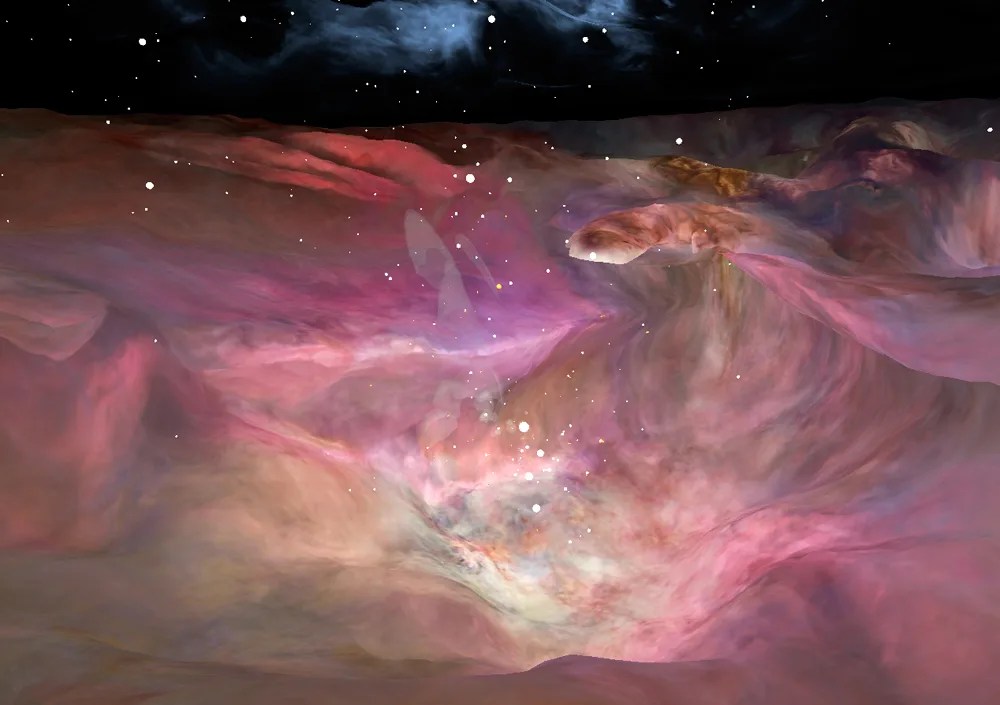5 min read
This image depicts a vast canyon of dust and gas in the Orion Nebula from a 3-D computer model based on observations by NASA's Hubble Space Telescope and created by science visualization specialists at the Space Telescope Science Institute (STScI) in Baltimore, Md. A 3-D visualization of this model takes viewers on an amazing four-minute voyage through the 15-light-year-wide canyon. Credit: NASA, G. Bacon, L. Frattare, Z. Levay, and F. Summers (STScI/AURA)
Take an exhilarating ride through the Orion Nebula, a vast star-makingfactory 1,500 light-years away. Swoop through Orion's giant canyon ofgas and dust. Fly past behemoth stars whose brilliant lightilluminates and energizes the entire cloudy region. Zoom by dustytadpole-shaped objects that are fledgling solar systems.
This virtual space journey isn't the latest video game but one ofseveral groundbreaking astronomy visualizations created by specialistsat the Space Telescope Science Institute (STScI) in Baltimore, the scienceoperations center for NASA's Hubble Space Telescope. The cinematicspace odysseys are part of the new Imax film "Hubble 3D," which openstoday at select Imax theaters worldwide.
The 43-minute movie chronicles the 20-year life of Hubble and includeshighlights from the May 2009 servicing mission to the Earth-orbitingobservatory, with footage taken by the astronauts.
The giant-screen film showcases some of Hubble's breathtaking iconicpictures, such as the Eagle Nebula's "Pillars of Creation," as well asstunning views taken by the newly installed Wide Field Camera 3.
While Hubble pictures of celestial objects are awe-inspiring, they areflat 2-D photographs. For this film, those 2-D images have beenconverted into 3-D environments, giving the audience the impressionthey are space travelers taking a tour of Hubble's most populartargets.
"A large-format movie is a truly immersive experience," says FrankSummers, an STScI astronomer and science visualization specialistwho led the team that developed the movie visualizations. The teamlabored for nine months, working on four visualization sequences thatcomprise about 12 minutes of the movie.
"Seeing these Hubble images in 3-D, you feel like you are flyingthrough space and not just looking at picture postcards," Summerscontinued. "The spacescapes are all based on Hubble images and data,though some artistic license is necessary to produce the full depth offield needed for 3-D."
The most ambitious sequence is a four-minute voyage through the OrionNebula's gas-and-dust canyon, about 15 light-years across.During the ride, viewers will see bright and dark, gaseous clouds;thousands of stars, including a grouping of bright, hefty stars calledthe Trapezium; and embryonic planetary systems. The tour ends with adetailed look at a young circumstellar disk, which is much like thestructure from which our solar system formed 4.5 billion years ago.
Based on a Hubble image of Orion released in 2006, the visualizationwas a collaborative effort between science visualization specialistsat STScI, including Greg Bacon, who sculpted the Orion Nebuladigital model, with input from STScI astronomer Massimo Roberto; theNational Center for Supercomputing Applications at the University ofIllinois at Urbana-Champaign; and the Spitzer Science Center at theCalifornia Institute of Technology in Pasadena.
For some of the sequences, STScI imaging specialists developed newtechniques for transforming the 2-D Hubble images into 3-D. STScI imageprocessing specialists Lisa Frattare and Zolt Levay, for example,created methods of splitting a giant gaseous pillar in the CarinaNebula into multiple layers to produce a 3-D effect, giving thestructure depth. The Carina Nebula is a nursery for baby stars.
Frattare painstakingly removed the thousands of stars in the image sothat Levay could separate the gaseous layers on the isolated Carinapillar. Frattare then replaced the stars into both foreground andbackground layers to complete the 3-D model. For added effect, thesame separation was done for both visible and infrared Hubble images,allowing the film to cross-fade between wavelength views in 3-D.
In another sequence viewers fly into a field of 170,000 stars in thegiant star cluster Omega Centauri. STScI astronomer Jay Andersonused his stellar database to create a synthetic star field in 3-D thatmatches recent razor-sharp Hubble photos.
The film's final four-minute sequence takes viewers on a voyage fromour Milky Way Galaxy past many of Hubble's best galaxy shots and deepinto space. Some 15,000 galaxies from Hubble's deepest surveys stretchbillions of light-years across the universe in a 3-D sequence createdby STScI astronomers and visualizers. The view dissolves into acobweb that traces the universe's large-scale structure, the backbonefrom which galaxies were born.
In addition to creating visualizations, STScI's educationgroup also provided guidance on the "Hubble 3D" Educator Guide, whichincludes standards-based lesson plans and activities about Hubble andits mission. Students will use the guide before or after seeing themovie.
"The guide will enhance the movie experience for students and extendthe movie into classrooms," says Bonnie Eisenhamer, STScI'sHubble Formal Education manager.
The Hubble Space Telescope is a project of international cooperation between NASA and the European Space Agency (ESA) and is managed by NASA’s Goddard Space Flight Center (GSFC) in Greenbelt, Md. The Space Telescope Science Institute (STScI) conducts Hubble science operations. The institute is operated for NASA by the Association of Universities for Research in Astronomy, Inc., Washington, D.C.








